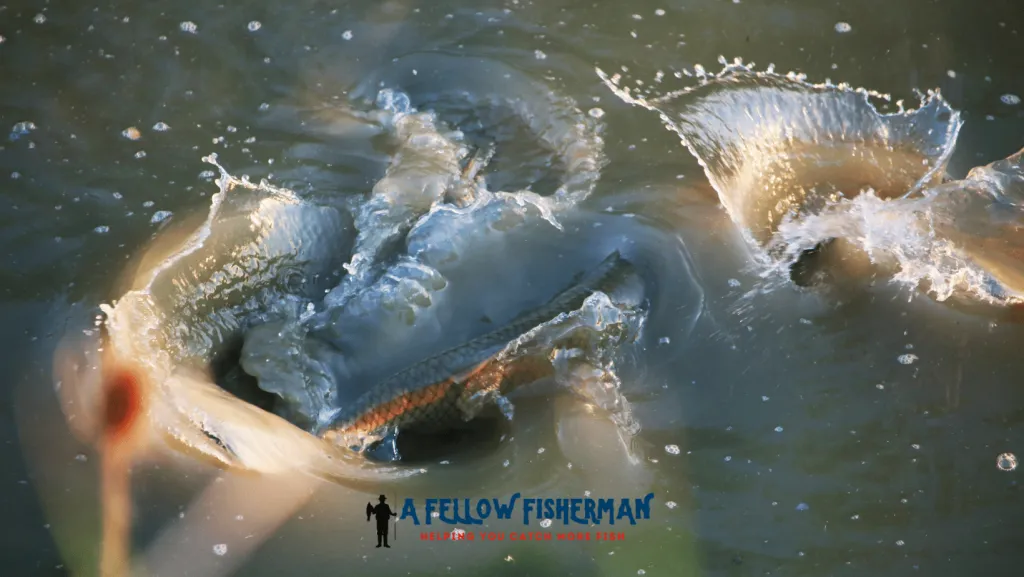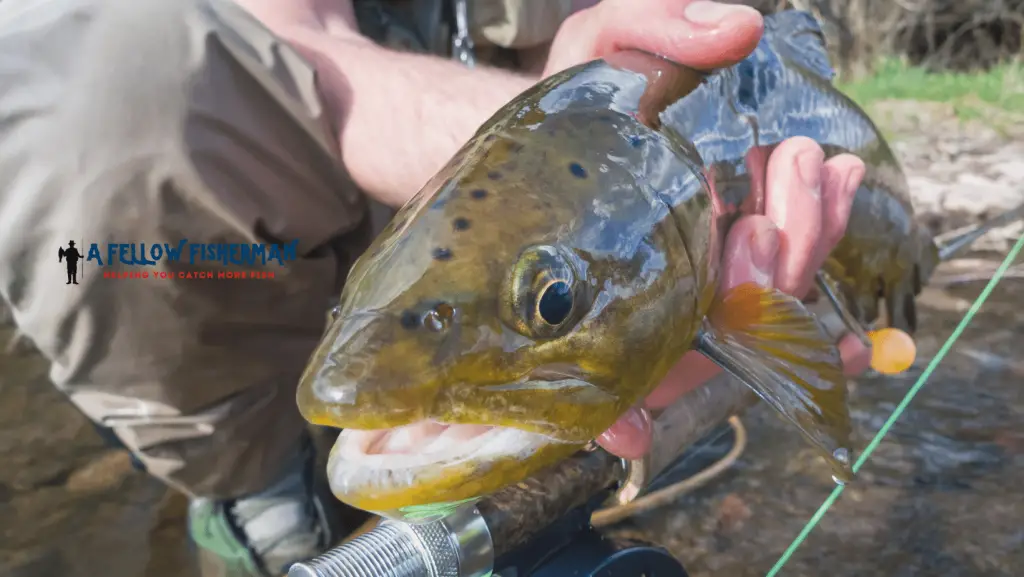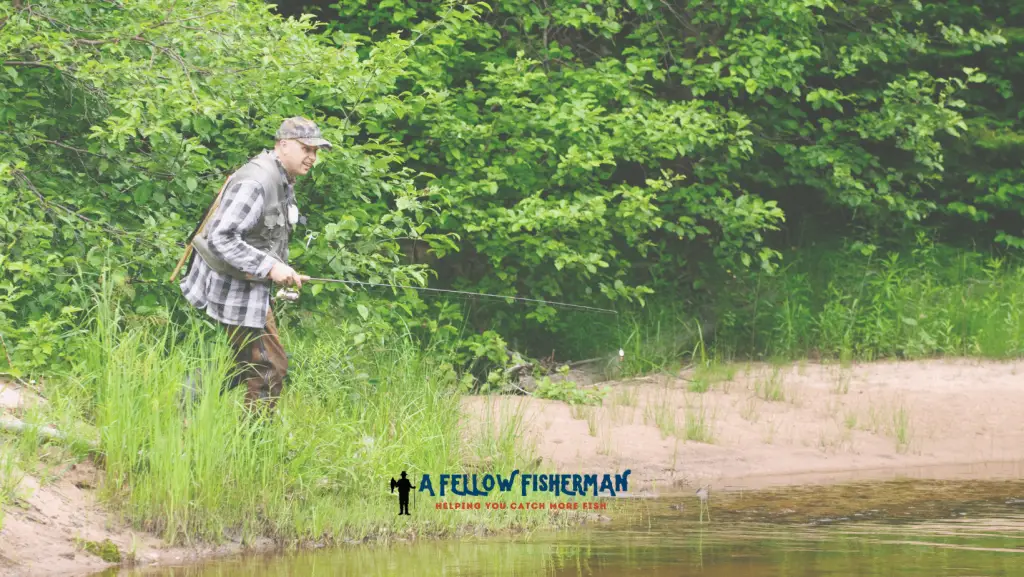
In this post, I will break down the best lure color for muddy water and other techniques to help catch fish in not-so-ideal water conditions.
You have that favorite lure that always catches fish. You probably have a few favorite spots to use the lure, but that green Blue Fox or the number 3 Five-of-Diamonds, or even a venerable Mepps Aglia spinner aren’t nearly as effective when the water turns brown.
Water condition is one of the most important factors to consider when fishing. In the Rockies of Colorado, Wyoming, and Montana, a fast-moving thunderstorm crossing the mountains 100 miles (160.93 km) away, will adversely affect fishing downstream just a few days later.
That crystal clear blue-ribbon trout stream suddenly begins to change color and in a few minutes the red runoff of dirt washed off a hillside a few days before ends your weekend of fishing.
But does it have to?
Best Lure Color for Muddy Water
We all prefer clear water. Fish can spot the glint of sunlight off a well-placed spinner or perhaps that darting spoon. As the end of your line twists back and forth, flashing just enough to catch the interest of a walleye, perch, pike, or trout on a lake. Light is your friend when conditions are perfect, but when the water is murky, muddy, or just filled with sediment, the light doesn’t reach the lure.
The fish we seek are all predators. They hunt smaller baitfish and that’s what lures are designed to mimic. Trout, walleye, largemouth bass, Northern pike, muskie, perch, and even small sunfish all prey on smaller fish. When the light is right, the hunting is great.
When it’s not, it’s time to change tactics.
You can catch fish in murky or muddy water with a standard lure, but you have to cast within a few inches of their nose to get any attention.
Largemouth bass are a little different, perpetually angry and aggressive, they’ll hit anything that moves around them.
Let the Force be With You
As Obi-Wan Kenobi tells Luke Skywalker in the original Star Wars, “Your eyes can deceive you, don’t trust them.”
When it comes to fishing muddy water, that advice rings true. You can’t trust your eyes because you can’t see anything through the suspended muck that was once clear water. The secret, as Obi-Wan Kenobi went on to tell his young Jedi student, is to trust your other senses, in other words, use the force.
That force in muddy water is sound and vibration. Fish don’t hear or sense movement as we do. Water is a great magnifier of sound and even more of vibration.
When the water gets murky, sound and vibration are your fishing friends.
Predatory fish are attracted to the minute sounds of baitfish swimming in schools. A lake trout will move onto a rock outcropping from the vibrations of thousands of minnows as they cruise above the protection of the rock crevices. They’ll often move in on vibration before they make visual contact with their prey.
Sharks are attracted to thrashing in the water, whether from seals or humans in wet suits that look like seals.
Making a Little Noise in the Water
Buzzbaits, crankbaits, rattle-baits, large blade sonic spinners, and hollow lures partially filled with tiny steel BBs are your best bet when the water isn’t crystal clear.
These are just generic suggestions, species-specific lures designed for limited viewing conditions are the best way to go. It requires a little research and a lot of trial and error, but with the right bait, you can still catch fish in muddy water.
Muddy Water Trout Fishing

We call them “trout” as a generic term for the entire genus. However, there are many differences in the various species of trout, not just in appearance, but it is how they hunt, where they prefer to live, and in how they strike.
Lake Trout
Lake trout, sometimes called Mackinaw will hit lures in clear water, but they’re a species best caught on live bait. They work deeper water, at maturity, they prey on larger fish and aren’t that impressed with many popular spinners and spoons. Trolling is a popular method of catching lake trout, but your trolling prospects diminish when the water gets dirty.
Rapala offers lures with rattling features, and these will have some success in attracting lake trout, but it’s not going to be a banner day with these fish when the water is dark brown.
Brook Trout
These aggressive little devils make fishing small streams a lot of fun. When those streams turn dark red from runoff, brook trout seek shelter behind large rocks or submerged logs in areas when the sediment is a little thinner. In the heavy runoff, it is hard for these fish to breathe, and they’ll either move off or die out.
The best lure for brookies in muddy water is often the Panther Martin spinner. Panther Martin advertises their popular spinners as producing sonic vibrations. If you’ve ever reeled in a Panther Martin on the light tackle, you can feel the difference from other lures.
Choose a bright color, flaming red or chartreuse, and smaller size, work the eddies and downstream side of rocks, bends, and deep sandbars, and you’ll find brook trout.
Brown Trout
These guys like minnows, they’re finicky and sometimes difficult to catch even in perfect water conditions. Fishing for browns when the water is brown, it is often a zero-sum game. You’ll spend an entire day throwing every noisy lure in your tackle box at them and likely not get a strike.
Rainbow Trout
The tail dancing, deep-diving gold medalist of the trout family can still be caught in muddy conditions. Rainbow trout are aggressive, they hit hard, similar to a bass, but in deeper water rather than the shallow strikes a large mouth prefers. Panther Martins, rattling Rapalas and even bright chartreuse Blue Fox spinners can get that electric thrill of a big rainbow battling on the end of your line.
Eating Good When the Water Isn’t: Walleye and Perch
Yellow perch and walleye are closely related species. That’s why they’re often considered the best eating freshwater fish. Walleye are substantially larger than perch, and perch hit harder than the soft biting walleye, but they’re attracted by the same lures.
Rattling Rapalas work well, but you’ll have to decide on the bill style to determine proper depth. The larger the bill on the lure, the deeper it will dive when you crank it. Rapalas are floating lures that dive when you retrieve them. A smaller bill only dips the lure into the water a few feet, while the longest can drop a lure to much greater depths, with the speed of your retrieve determining just how deep they’ll go.
Finding the right depth in muddy water is trial and error, but once you locate a school of perch or find the spot that walleyes are moving through after baitfish all the effort is worth it.
Northern Pike and Muskie
They look like freshwater barracuda, and they hunt their prey similarly. These fish are sight predators, perhaps more than any of the other popular game fish.
Pike and muskie are best caught on bright sunny days. If you’re after these two species, it’s best to wait for the water to clear.
Largemouth Bass
Bass fishing is fun, there is no other way to say it. Even when they’re only 10 or 12 inches (0.3 m) long, large mouth bass is a real kick. These ambush predators lay in wait and attack anything that comes near them.
Legends of hooking a treble hook on a beer can and tossing it into the reeds then catching a big largemouth are indicative of the aggressiveness of these fish.
That’s why bass fishing tournaments are the most popular of any species.
The good news is that bass fishing is not as affected by muddy or turbid water as other freshwater fish.
Bass are attracted by sound and movement.
Large mouth bass often suspends in murky water, surrounded by algae, and wait to strike as fish, frogs, crawdads, or even snakes and birds swim by overhead.
You can catch bass on almost any lure, but they prefer surface baits like jitterbugs, poppers, buzz baits, and that best lure of all time for largemouth, the plastic worm.
Fishing for largemouth bass in muddy conditions isn’t that much different than when the water is clear.
Bass will hide in the cattails, under lily pads, or around sunken logs, waiting for the sound of unwary prey to swim near them.
Bass eat mice, snakes, minnows, ducklings, salamanders, newly hatched turtles, and alligators, in short, they’ll hit and eat just about anything that comes close to them.
Poppers don’t work as well in muddy water, but crankbaits and noisy buzz baits will still generate strikes.
If you have a bass pond or section of a river you often fish for largemouth bass, don’t worry about the water conditions, just go have some fun.
Conclusion

Water makes a big difference in what you can use to attract fish, and in how the fish react to your lure.
Bright colors work better than the standard brass, black or dark red lures, but color alone won’t catch all species of fish when the water is muddy, or filled with sandy sediment.
Make a little noise in the water, choose a lure that vibrates, that makes a little flash in the water and no matter the conditions, you’ll still catch fish.
For more tips and guides, check out the pages below:










